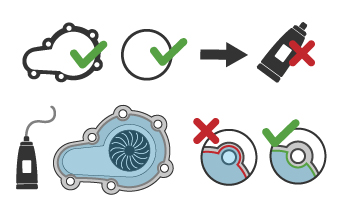The majority of water pump failures are caused by some other factor than a bad-quality water pump. It’s easy to blame the pump. But, it takes a good technician to identify the root cause and correct the situation before another water pump fails. A faulty mechanical seal caused by bad installation practices is the most common cause of premature water pump failure.
WHY DO WATER PUMPS FAIL?
Before you replace any water pump in a car, you have to diagnose why it failed. The average water pump handles 1.7 million litres of coolant in about four years, or 100,000km/60,000mi. If a water pump fails sooner and is replaced without an investigation, the new pump is likely condemned to an even shorter life. To understand what made the water pump fail will lead to the root cause and the corrective action.
THE MOST COMMON DAMAGE TO A WATER PUMP: CAUSES AND CORRECTIVE ACTIONS
Most water pump warranty cases are due to errors during the installation process.
1. DRY ROTATION OF THE WATER PUMP

As well as helping to keep the engine cool, coolant plays an important role in forming an efficient seal inside the water pump. This so-called mechanical seal is a “dynamic seal” typical for rotating equipment such as pumps. When a water pump operates, the liquid could leak out from the small gap (just a few micrometers wide) between the pump’s internal two rings that rotate relative to one another (one ring rotates with the shaft, the other ring is stationary). In order to avoid this leakage, a fluid barrier formed by coolant between the rings is needed. Dry rotation of the water pump can permanently damage the rings, leading to premature noise and/or coolant leakage.
How to avoid: First refill the cooling circuit with coolant, then rotate the pump’s drive pulley about ten times without the belt tensioned on the pulley. This will allow a small amount of coolant to form the mechanical seal before the engine is started. If this is not possible because e.g. radiator hoses are disconnected, or, if you want to test the new pump’s rotation ability before installation, it is a good idea to pour some new coolant over the pump holding it the impeller-side upwards before rotating it about ten times. Alternatively, you could also fill a reservoir with new coolant and immerse new pumps to safely test them.
Notes:
- If an engine would be started with a dry pump, do not hit the gas but let it run for one minute at idle speed.
- Lip seals are occasionally also used instead of mechanical seals.
2. IMPROPER USE OF SEALS/GASKETS OR SEALANT

This can easily cause the water pump to be improperly seated or even worse can damage some sensitive components such as seals, leading to coolant leakage.
How to avoid: Old gaskets and seals should be replaced by new ones. Only apply sealant if specifically recommended by the manufacturer. If the pump has a gasket or seal (O-ring or other), sealing paste should not be applied as adding it can actually cause problems. Sealant should also be used in the correct way. Put an even thin bead of sealant along the edge and around the coolant passages (installation holes) on impeller-side of the pump. Too much sealant compromises the correct installation. It can lead to misalignment of the pump once you start torqueing the bolts, plus, excess paste in fact often ends up in the cooling circuit where it can cause considerable damage. Sealants are also made with different drying rates, so respect the sealant’s printed instructions.
3. BAD OR WRONG COOLANT

Contaminated coolant, non-compatible coolant, or mixing coolants of different chemistries leads to premature water pump failure. Harmful contamination is common in systems that are not properly maintained. The contaminants (abrasive particles, engine oil…) scratch the water pump’s internal seals or affect their wear resistance, creating a path for coolant leakage. Non-suitable coolant does not offer the required protection level against rust and corrosion, destroying the pump’s individual components.
How to avoid: Completely drain and thoroughly flush the cooling circuit before installing a new water pump. The coolant should be entirely replaced with the correct vehicle manufacturer’s recommended coolant. The cooling system is considerably more complex than it once was, and incorporates components made from many different materials. The need to protect these components from rust and corrosion is the key reason behind the growth of vehicle-manufacturer-approved coolants.
4. DEFECTIVE OR IMPROPERLY INSTALLED BELT DRIVE COMPONENTS

It is important not to overlook the relationship between the water pump and the belt drive system. A worn or improperly installed belt or tensioner will cause the water pump to cease (the same as a defective or improperly installed water pump will cause the belt drive to fail prematurely).
How to avoid: By changing the belt drive and water pump at the same time using an all-in-one kit, the lifetime of the belt drive and water pump is optimised and the risk of premature failure is minimised. Carefully follow the fitting instructions, tensioning procedure and torque specifications devised by the manufacturer.
IS A LITTLE BIT OF COOLANT AROUND THE WEEP HOLE NORMAL?
When a water pump is new, some seepage from the weep hole is normal as it takes some time for the mechanical seal to properly seat itself (break-in period).
This is no cause for concern. Once the mechanical seal has seated itself, the seepage will stop. More pronounced seepage and drips from the weep hole after this break-in period or a large coolant bleed mark around the weep hole are abnormal and indicate impending water pump failure.
If you complete a full system overhaul and carefully follow the manufacturer’s instructions you will be able to provide your customer with another 100,000km/60,000mi of reliability.
View more information about
key signs which indicate that a water pump needs to be replaced and
general water pump installation tips.